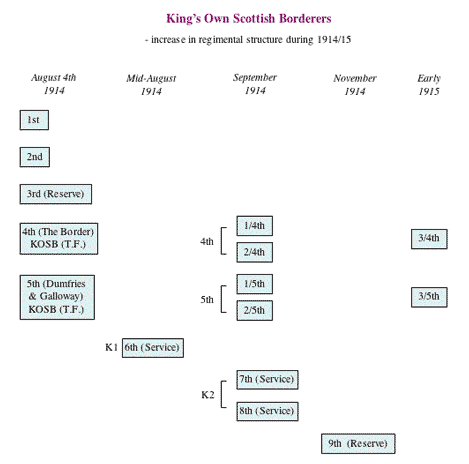The British Army in 1914
Guide to British Army infantry organisation
A glossary of the terms used to describe the various tactical
formations used by the British Army is listed below. The glossary is arranged
in order of formation size (largest to smallest), with the exception of
Regiment because it represents an organisation rather than a specific tactical
unit. The numbers stated in the last column apply to full establishment
in 1914. In early 1915 the battalion strength increased to 1,021 men due
to the allocation of machine guns being doubled to four.
| Formation | Abbreviation | Definition of the formation and its place in the organisational scheme | Establishment |
|---|---|---|---|
| Army | Made up of two or more corps. Corps were allocated to armies as required. Armies reported up to General Headquarters (GHQ) | ||
| Corps | Made up of several divisions. Divisions were allocated to and from Corps as required | ||
| Division | Div | Largest self-contained tactical formation, comprising units of all ground forces (infantry, artillery, engineers, transport, signals, medical, training units). Contained three infantry brigades | More than 18,000 men and 5,000 horses |
| Brigade | Bde | Intermediate formation between division and battalion. In 1914 it consisted of brigade headquarters and four battalions. The battalion quota was reduced to three in early 1918 | 4,055 men and 247 horses |
| Battalion | Bn | Basic tactical formation, comprising a battalion HQ and four companies | 1,007 men, of whom 30 were officers |
| Company | Coy | Subdivision of a battalion, consisting of a Coy HQ and four platoons | 227 men, of whom 6 were officers |
| Platoon | Subdivision of a company. Four sections made up a platoon | ||
| Section | Subdivision of a platoon. Smallest recognised unit within a battalion | 12 men under an NCO | |
| Regiment | Regt | Not an actual body of men, but an organisation under which a number of battalions are formed and maintained |
Regular, Reserve and Territorial Force battalions
At the outbreak of WW1 the Infantry of the British Army was comprised of four Guards Regiments and 69 Infantry Regiments. The men who served in these regiments can be divided into two categories: full-time, regular soldiers and part-time territorial soldiers.
The regiments usually consisted of two active service Regular
battalions and one Reserve battalion, numbered in order, e.g., 1st and 2nd
KOSB and 3rd (Reserve) KOSB. At any one time, one Regular Battalion would
serve overseas while the other remained in Britain for home defence (all
Guards battalions remained in Britain for home defence duties). The Reserve
battalion, usually based at the Regimental Depot, was deployed in training
new soldiers and supplied drafts to the two Regular battalions.
The majority of regiments also had Territorial Force battalions. These battalions trained their own (part-time) soldiers and so there were no associated reserve battalions. The Territorial Force battalions were numbered in sequence after the Regular and Reserve battalions, e.g., 4th (The Border) Bn., KOSB, and 5th (Dumfries and Galloway) Bn., KOSB.

In September 1914 the organisation of the Territorial Force battalions was altered to take into account the different terms men signed when volunteering for their local battalion: home service only, or home service and overseas if required. As a result one battalion would have a mixture of both categories. The battalions were split into first and second line units and given fractional numbers, e.g., 1/5th and 2/5th Bns., KOSB. Initially the second line battalion was for home service only, but later in the war some did serve overseas. By the summer of 1915 most Territorial Force battalions had formed a third line, e.g, 3/5th Bn., KOSB, and these battalions were used for training and supplying drafts of men to both the first and second line battalions.
Service battalions
On 7th August 1914 Lord Kitchener, Secretary of State for War, started a campaign to recruit an additional 100,000 men between the ages of 19 and 30. Lord Kitchener's chose not to use the structure of the Territorial Force for increasing the Army's size; instead his "New Armies" were created as Service battalions of the existing regiments. The Service battalions were numbered in sequence after the Regular, Reserve and Territorial battalions, e.g., 6th (Service) Bn., KOSB.
The call for recruits received an overwhelming response and, ultimately, more than 500 New Army battalions were raised. The battalions raised from August to September 1914 formed the three Kitchener Armies: K1 (9th-14th Divisions), K2 (15th-20th Divisions) and K3 (21st-26th Divisions).
